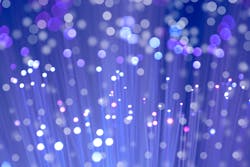As I discussed in my BTR column last month, cable operators are embracing a high-fiber diet like never before, deploying fiber-to-the-premises (FTTP) systems and advanced PON technology throughout the world. So, what could this mean for cable operators and subscribers as the new year beckons?
Faster speeds
Well, for one thing, it should mean significantly faster broadband speeds for both consumers and businesses. Leading cable operators like Comcast and Altice USA in North America, and Liberty Global and Vodafone in Europe, are already rolling out multi-gig speeds in their territories, thanks in large part to the construction of new FTTP networks and/or the extension of fiber lines in their legacy hybrid fiber/coax (HFC) networks.
Take Altice USA as a prime example. Altice, the country’s third biggest cableco, is now rolling out symmetrical 2-gig and 5-gig services over its new all-fiber networks in parts of the New York metro area. The operator plans to extend these multi-gig services to the more than 2 million homes it now passes with fiber throughout the nation, along with 4 million-plus more households that it plans to reach with fiber links over the next three years.
Dennis Mathew, the new Altice USA CEO and a former long-time Comcast executive, lauded his new company’s strategy to upgrade most of its cable territories to FTTP platforms while speaking on the company’s third-quarter earnings call last month. Under this strategy, the cable company, unlike most of its chief counterparts, plans to skip over the new DOCSIS 4.0 spec and go straight to all-fiber.
“I’m a big believer in fiber as the best broadband technology that exists today, so that’s a key tenet of the Altice strategy,” Matthew said on the earnings call. “We are starting to see the benefit of these investments and are confident we can continue delivering on our renewed promise and commitment to our customers and communities.”
Similarly, Comcast is now prepping to introduce symmetrical multi-gig speeds throughout its regions, using a combination of legacy HFC systems and new FTTP networks. The nation’s largest cable company aims to offer symmetrical 2-gig and higher speeds to its entire footprint of 50 million homes and businesses before the end of 2025.
In their third-quarter earnings call in late October, Comcast executives reiterated their commitment to rolling out symmetrical multi-gig speeds starting in the second half of 2023. While they highlighted the role that DOCSIS 4.0 will play in that rollout, they have also been quietly building fiber extensions to their HFC networks in many areas.
In fact, thanks to the explosion of fiber network builds and extensions and the cable industry’s competitive response to those builds, 1-gig speeds are rapidly becoming the norm in many parts of the world. And multi-gig speeds appear to be not too far behind.
For instance, a survey of 760 fixed broadband providers across the globe earlier this year by Omdia, a unit of Informa Tech, found that an impressive 60% of providers now offer 1-gig or higher speeds to their residential subscribers. That's up from 45% just three years earlier. Zeroing in on North America, the Omdia study also revealed that a whopping 88% of U.S. and Canadian fixed-line providers now offer at least 1-gig speeds to their residential subscribers while 16% already offer multi-gig service.
Moreover, Omdia projects that by 2026, the end of its current forecast period, 67 million subscribers, or 50% of all North American broadband customers, will be paying for broadband speeds of 500 Mbps or more. Plus, they expect that by then, close to 20% of those customers will be subscribing to speeds of more than 1 gig.
Google Fiber is certainly sensing and fostering that trend. One of the original U.S. fiber evangelists, Google Fiber has been rolling out 2-gig downstream/1-gig upstream services in its two dozen or so FTTP markets across the nation. It plans to start offering symmetrical 5-gig and 8-gig services in its regions early next year.
“We used to get asked, ‘who needs a gig?’ Today it’s no longer a question,” wrote Google Fiber CEO Dinni Jain in a blog post earlier this year. “Every major provider in the U.S. seems to have gotten the gigabit memo, and it’s only going to go up from there – some providers are already offering 2, 5, 8, even 10-gig products.”
But more than speed as well
Higher data transmission speeds are not the only benefits that fiber is bringing to the broadband market. The swiftly growing deployment of FTTP lines is also ushering in improved customer service, better online experiences and even, dare we say it, a higher quality of life for subscribers.
A customer feedback survey of 2,500 fiber subscribers conducted this fall by Utopia Fiber, a publicly owned FTTP network serving more than 50 Utah communities, bears this out. In the survey, more than 85% of subscribers said access to the provider’s new fiber network has improved the quality of their lives. Similarly, 76% of survey participants said their communities have become better places to live because of the easy availability of fiber.
“Numbers don't lie. Americans who have access to high-speed internet have vastly better lives than those who lack connectivity,” said Kimberly McKinley, deputy director and chief marketing officer (CMO) of Utopia Fiber, in a written statement. “The big takeaway here is that internet is life, and either you have it or you don’t.”
Likewise, in a survey of 3,000 U.S. consumers conducted last May for the Fiber Broadband Association, RVA LLC Market Research & Consulting found that FTTP has played a key role in improving the quality of jobs, education, and health care in fiber-served communities. To cite several highlights from the study, markedly more people with fiber connections said they could work from home and enjoyed good access to health care and education than those without the same fiber links.
“The overall point is that there is a real differentiation in terms of fiber versus other means of delivery,” said Mike Render, founder and CEO of RVA. “Barring some breakthrough in physics, I don’t see that changing.”
Moreover, deploying FTTP networks clearly generates economic gains for the communities that go the fiber route. A prime example of that is Chattanooga, TN, which bills itself as the nation’s “first gig city” after pouring $220 million into a fiber network build a decade ago. Although that investment was initially greeted with great skepticism, it has paid handsome financial dividends for the city and its surrounding suburbs.
Indeed, in an independent study, the University of Tennessee found that this spending has delivered an approximately $2.7 billion return on investment over the first 10 years, directly supporting the creation or retention of nearly 10,000 jobs in the metro region. In addition, the study concluded, the fiber network outlay has helped to lower the local unemployment rate, reduce the number of power outages, and build a larger tax base to support increased public service funding.
Similarly, both Douglas County, OR, and Westfield, MA, have reported reaping healthy economic gains from subsidizing fiber deployment in their communities. In Westfield’s case, for example, the city of 41,000 reported earlier this year that it has already seen more than $88 million per year in employment-related benefits, the creation of more than 4,600 work-from-home jobs, and an increase in home values from its 152-mile fiber network.
“We wanted to offer an internet service to Westfield that was future-proof and cutting edge,” said John Leary, information technology manager at Westfield Gas & Electric. “To accomplish that, we knew we needed fiber.” Plans call for the utility's Whip City Fiber service, which now offers symmetrical 1-gig speeds, to deliver broadband service to all of Westfield and boost speeds to 10 Gbps by 2025.
Power and environmental benefits
Finally, deploying more fiber leads to greater environmental benefits for both service providers and their communities. That’s because FTTP networks require far less power to operate than do copper and cable networks and pump far less pollutants into the air and water.
In a report on the telecom industry’s environmental impact earlier this year for the World Broadband Association (WBA), Omdia calculated that telecom’s carbon dioxide (CO2) footprint now accounts for roughly 2% of the total global CO2 footprint, similar to that of the airline industry. The study also reported that telecom and IT equipment is a major contributor to e-waste that’s discarded, burned, or illegally traded.
Yet, in a hopeful sign, the Omdia study noted that several large telecom providers in Western Europe and New Zealand have slashed both their energy consumption and carbon emissions by shifting from legacy copper networks to new FTTP systems. As a result, the study concludes that fiber networks are much greener and more sustainable than both their cable and copper antecedents.
“FTTH consumes three times less electrical power than traditional copper-based networks and up to six times less electrical power than cable networks,” wrote Alzbeta Fellenbaum, a principal analyst for broadband and bundling at Omdia who authored the WBA report. With the help of fiber builds, she argued, “telecom service providers have the potential to affect up to 15% of global CO2 emissions.”
Fiber makes sense
Thus, deploying fiber, or more fiber, makes sense for cable operators for many reasons that range from competitiveness and customer service to economic dividends and environmental quality. The big question now is how quickly operators can make the transition to all-fiber networks.
“Every ISP out there with the possible exception of the largest MSOs is now trying to build fiber as quickly as they can,” said RVA’s Mike Render. “Over the next five years, all of this activity is going to lead to the biggest fiber build we’ve ever seen.”
I couldn’t agree more.
Gary Bolton is president and CEO of the Fiber Broadband Association.





